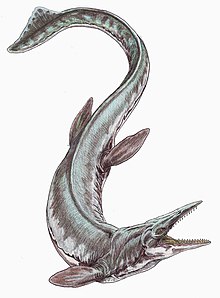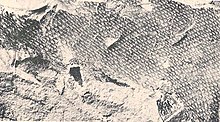海王龙属
| 海王龙属 化石时期:
| |
|---|---|

| |
| 科学分类 | |
| 界: | 动物界 Animalia |
| 门: | 脊索动物门 Chordata |
| 纲: | 爬行纲 Reptilia |
| 目: | 有鳞目 Squamata |
| 总科: | †沧龙总科 Mosasauroidea |
| 科: | †沧龙科 Mosasauridae |
| 亚科: | †海王龙亚科 Tylosaurinae |
| 属: | †海王龙属 Tylosaurus Marsh, 1872 [1] |
| 模式种 | |
| 船首海王龙 Tylosaurus proriger Cope, 1869
| |
| 种 | |
| |
| 异名 | |
| |
海王龙属(属名:Tylosaurus)又名瘤龙、节龙,意为“鼻部呈球状的蜥蜴”,是一种拥有活动关节下颚的大型海洋蜥蜴,属于晚白垩纪晚期西部内陆海道中的顶级掠食动物。海王龙演化出圆筒状的前上颌骨和双铰链状的牙槽,既可用来撞击、打昏猎物,也可用在物种内打斗。海王龙在阿拉巴马州的Eutaw组与Mooreville的白垩层中偏好浅海环境,但在美国西部的尼奥布拉拉白垩层中则能适应深海。
船首海王龙(T. proriger)为海王龙属的模式种,海王龙自身可长到约14米或更长,与倾齿龙属、沧龙属并列为最大的沧龙类。作为较早大型化的沧龙类,海王龙的鲨鱼状尾鳍和鱼形身体较为不明显,身躯和沧龙属相比保留着更多的蜥蜴特征。海王龙的鳍状肢大且身体丰满,呈现鲔鱼型,具有活动关节化的下颚骨,能像蛇一样丸吞这个猎物,这项能力是较晚期的沧龙超科所没有的,显示出它们的生活习惯更加接近于现代的巨蜥和蛇,可动式下颚骨还让海王龙胃部中发现了众多完整的动物化石,例如蛇颈龙类、鲨鱼、鱼类、菊石与其他小型沧龙类,这对于研究海王龙及当时海洋的生态具有正面意义。
发现[编辑]


就像发现其他化石的背景一样,发现海王龙时的早期历史相当地复杂,这段历史与发现海王龙的两位美国早期古生物学家奥塞内尔·查利斯·马什(Othniel Charles Marsh)以及爱德华·德林克·科普(Edward Drinker Cope)之间恶名昭彰的竞争对抗有关。在1869年,科普根据前一年在堪萨斯州西部所发现的零碎的头骨与3节脊椎骨,提议命名为Macrosaurus proriger。[4]该化石现在存放于哈佛大学比较动物学博物馆内。
仅仅在一年之后,科普重新更详细的描述该化石,而且归类于英国的沧龙类平齿蜥(Liodon)。然后在1872年,马什根据更完整的化石,命名了一个新的属Rhinosaurus,但是很快的这个名称被证实已经登记在案了。科普建议以Rhamposaurus来取代Rhinosaurus,不过这个名称也被证实被抢先使用。马休最后在1872年确立了海王龙(Tylosaurus)这个名称,来包括存放于哈佛大学比较动物学博物馆内的沧龙类化石,以及其他在堪萨斯州所发现更完整的化石。[1]在1911年,C. D. Bunker在靠近堪萨斯州的华勒斯发现了一个巨大的物种T. proriger,这也是目前发现过最大的海王龙化石之一。现在它被展示在堪萨斯大学的自然史博物馆内。
在1918年,查尔斯·斯腾伯格(Charles H. Sternberg)发现一个海王龙化石的胃部区域,有个蛇颈龙类的化石。[3]这个标本目前位于史密森尼学会 。虽然该化石曾在1922年被简略地叙述,要直到2001才被重新研究。

注意这张海王龙头骨的早期照片,是由古生物学家乔治·史登柏格(George F. Sternberg)在收集与组装好化石后,于1926年所摄,化石是在堪萨斯州洛根郡的斯莫基希尔白垩层所发现的。后来史登柏格提供化石给史密森尼博物馆,而且写了一封信给查尔斯·吉尔摩(Charles Gilmore),里面包括了这张照片,科普早期的照片也存放在史登柏格博物馆,后来这个标本被标示为FHSM VP-3。
种[编辑]


过去许多年来,已有许多种海王龙被命名,但其中只有少数被科学家认为是有效种,包含:普氏海王龙(T. proriger),发现于堪萨斯州、阿拉巴马州、内布拉斯加州,年代为桑托阶到坎潘阶;[4]Tylosaurus nepaeolicus发现于堪萨斯州,年代为桑托阶;[5]Tylosaurus haumuriensis发现于新西兰,年代为坎潘阶;堪萨斯海王龙(T. kansasensis)发现于堪萨斯州,年代为晚康尼亚克阶。[6]
海王龙的近亲海诺龙生存于白垩纪的北美洲与欧洲。海王龙与海诺龙都属于海王龙亚科。[7]Bell在1997年将海王龙亚科与扁掌龙亚科(板踝龙与扁掌龙)归类于罗赛尔龙亚科,罗赛尔龙亚科是个非正式的单系群。[8]

大众文化[编辑]
很多古生物纪录片和恐龙电影中的“沧龙”,为追求视觉上的庞大效果而不采用沧龙属的建模,经常以本条目的海王龙属代替。
- 海王龙曾出现在BBC的电视节目《海底霸王》(Sea Monsters)。该节目介绍历史上七大致命海域,海王龙出现在最后介绍、也是最危险的白垩纪海洋单元中捕食剑射鱼。一群海王龙反复攻击节目主持人奈吉尔·马文翻覆的救生艇,最后一群海王龙逼近节目主持人团队所乘坐的远洋船,团队最后生死不明。该节目将海王龙称为沧龙。
- 海王龙还出现在国家地理杂志的电视节目《海洋之兽:史前探险》(Sea Monsters: A Prehistoric Adventure),同样也被介绍为白垩纪的顶级掠食动物。
- 海王龙也出现在探索频道的电视节目《恐龙王朝》(Dinosaur Revolution)中,一只怀孕的雌性海王龙在海中产下后代,但引来鲨鱼群的攻击,最后该海王龙杀光吞噬自己后代的鲨鱼群,并成功救下幸存的后代。节目也将其称为沧龙。
- 探索频道的电视节目《远古巨兽大复活》(Monsters Resurrected)中出现的沧龙,其实是海王龙。节目中的海王龙同样被描述为白垩纪的顶级掠食动物,以白垩尖吻鲨和蛇颈龙目为食。
- 海王龙也出现在韩国3D电影《特暴龙》(Tarbosaurus 3D),两只海王龙一起将落下海的红暴龙ONE-EYE咬死并吞噬。
参考资料[编辑]
- ^ 1.0 1.1 Marsh OC. 1872. Note on Rhinosaurus. American Journal of Science 4 (20): 147.
- ^ Paulina Jimenez-huidobro and Michael W. Caldwell. Reassessment and reassignment of the early Maastrichtian mosasaur Hainosaurus bernardi Dollo, 1885, to Tylosaurus Marsh, 1872. Journal of Vertebrate Paleontology. 2016,. Online edition (3): e1096275. doi:10.1080/02724634.2016.1096275.
- ^ 3.0 3.1 存档副本. [2008-11-27]. (原始内容存档于2012-06-29).
- ^ 4.0 4.1 Cope ED. 1869. [Remarks on Macrosaurus proriger.] Proceedings of the Academy of Natural Sciences of Philadelphia 11(81): 123.
- ^ Cope ED. 1874. Review of the vertebrata of the Cretaceous period found west of the Mississippi River. U. S. Geological Survey of the Territories, Bulletin 1 (2): 3-48.
- ^ Everhart MJ. 2005. Tylosaurus kansasensis, a new species of tylosaurine (Squamata: Mosasauridae) from the Niobrara Chalk of western Kansas, U.S.A. Netherlands Journal of Geosciences / Geologie en Mijnbouw 84 (3): 231-240.
- ^ Williston SW. 1898. Mosasaurs. The University Geological Survey of Kansas, Part V. 4: 81-347 (pls. 10-72).
- ^ Bell GL. Jr. 1997. A phylogenetic revision of North American and Adriatic Mosasauroidea. pp. 293-332 In: Callaway J. M. and E. L Nicholls, (eds.), Ancient Marine Reptiles, Academic Press, 501 pages.
- Bell GL. Jr. 1997. Part IV: Mosasauridae - Introduction. pp. 281–292 In: Callaway J. M. and E. L Nicholls, (eds.), Ancient Marine Reptiles, Academic Press, 501 pages.
- Everhart MJ. 2001. Revisions to the biostratigraphy of the Mosasauridae (Squamata) in the Smoky Hill Chalk Member of the Niobrara Chalk (Late Cretaceous) of Kansas. Kansas Academy of Science, Transactions 104 (1-2): 56-75.
- Everhart MJ. 2002. New data on cranial measurements and body length of the mosasaur, Tylosaurus nepaeolicus (Squamata; Mosasauridae), from the Niobrara Formation of western Kansas. Kansas Academy of Science, Transactions 105 (1-2): 33-43.
- Everhart MJ. 2005. Earliest record of the genus Tylosaurus (Squamata; Mosasauridae) from the Fort Hays Limestone (Lower Coniacian) of western Kansas. Transactions 108 (3/4): 149-155.
- Everhart MJ. 2005. Oceans of Kansas - A Natural History of the Western Interior Sea. Indiana University Press, 322 pp.
- Kiernan CR. 2002. Stratigraphic distribution and habitat segregation of mosasaurs in the Upper Cretaceous of western and central Alabama, with an historical review of Alabama mosasaur discoveries. Journal of Vertebrate Paleontology 22 (1): 91-103.
- Russell DA. 1967. Systematics and morphology of American mosasaurs (Reptilia, Sauria). Yale Univ. Bull. 23: 241 pp.
- Novas FE, Fernández M, Gasparini ZB, Lirio JM, Nuñez HJ, Puerta P. 2002. Lakumasaurus antarcticus, n. gen. et sp., a new mosasaur (Reptilia, Squamata) from the Upper Cretaceous of Antarctica. Ameghiniana 39 (2): 245-249.
外部链接[编辑]
- Oceans of Kansas; includes much additional information and many illustrations and photographs of tylosaurines, including restorations and skeletons. (页面存档备份,存于互联网档案馆)
- E.D. Cope's original description of Macrosaurus proriger from western Kansas, with the published figure (1870) and recent photographs. (页面存档备份,存于互联网档案馆)
| |||||||||||||||||||||||||||||||||||||||||||||||||||||||||||||||||||||||||||||||||||||||||||||||||||||||||||||||||||||||||||||||||||||||||
|


